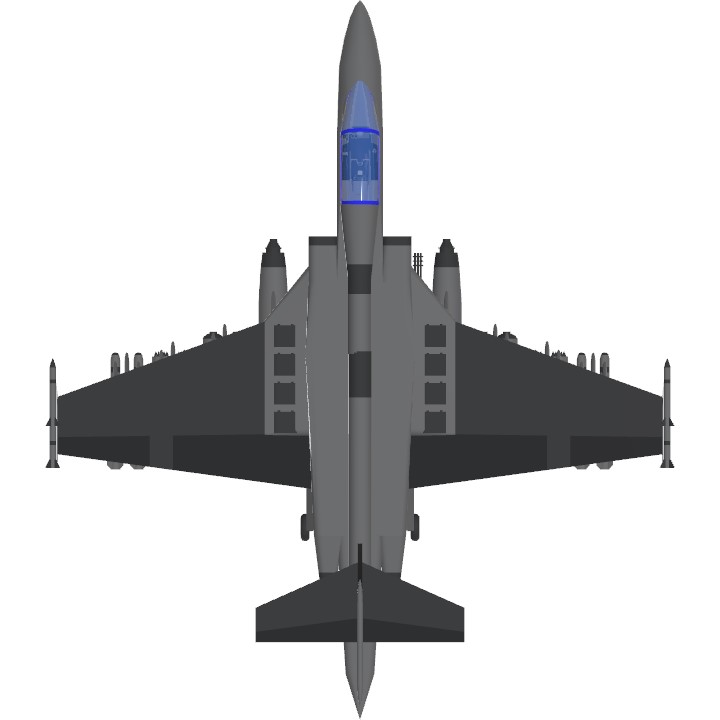The Aichi Kokuki Ha-72 Saiun (lit. Iridescent Cloud) is a Japanese subsonic, single-seat, twin-engine ground-attack aircraft designed by Aichi Kokuki for Japan's Army Air Arm as a long-range, hard-hitting ground-attack aircraft purpose-built for the role of close air support. The first prototype made it's maiden flight in mid-1970 and the aircraft went into production shortly after, with the first squandrons becoming operational in early 1972. The aircraft lacked in speed compared to other aircraft in service at the time, but made up for it significantly in raw payload and firepower, being able to carry a respectable 5,700 kg (12,566 lb) in payload to deliver against ground targets. Despite that, the aircraft is not a pushover in the air-to-air role, however, as it's simple, high-lift, high payload design makes it incredibly maneuverable, especially at lower speeds, and it' sheer amount of air-to-ground ordinance allows it to virtually flood the airspace in air-to-air missiles. The Ha-72 is also similarly known for it's survivability and durability, during testing, one unmanned aircraft was shot at by a 25mm autocannon emplacement and returned to land safely, despite sustaining so much damage that as the test crew put it, "more holes than an equivalently-sized piece of Swiss cheese".
Overview
Role: Ground-attack aircraft
Origin: Japan
Manufacturer: Aichi Kokuki
First flight: 17th May 1970
Introduction: February 1972
Operators: Army Air Arm (Japan), Marine Air Arm (Japan)
Developed from: Aichi Ha-70
Produced: 1970-current
Number built: est 700 (not counting exports)
General characteristics
Crew: 1 pilot
Wingspan: 37.3ft (11.4m)
Length: 51.3ft (15.6m)
Height: 13.2ft (4.0m)
Empty Weight: 27,000 lb (12,266 kg)
Loaded Weight: 40,000 lb (18,143 kg)
Gross weight: 54,00 lb (24,493 kg)
Max takeoff weight: 70,000 lb (31,571 kg)
Wing Area: 409.0ft2 (38.0m2)
Powerplant: 2x Mitsubishi Hikari low-bypass afterburning turbofan engines, 9,930 lbf (44.18 kN) thrust each dry, 13,770 lbf (61.25 kN) with afterburner
Performance
Top speed: 600 kts (690 mph, 1111 km/h)
Cruise speed: 500 kts (575 mph, 926 km/h)
Range: 1,000 km (620 mi, 540 nmi) standard load under cruise speed
Service ceiling: 7,000 m (23,000 ft)
g limits: +6.5
Wing Loading: 99.1lbs/ft2 (483.9kg/m2)
Power/Weight Ratio: 1.662
Armament
1x 30mm Type 67 aircraft heavy aircraft rotary autocannon (1,500rds)
11 external hardpoints (+8 with double-rack hardpoints)
Type 57 anti-ship/anti-air missile
Type 58 anti-air missile
Type 70 anti-air missile
Type 68 2,100lb (952 kg) guided bombs
Type 97 2,700lb (1,224 kg) bombs
Type 98 1,000 lb (500 kg) bombs
Type 70 oxygen torpedoes
Type 59 air-to-surface missiles
Type 70 rocket pods
up to 3 × 600 gal (2,300 L) external drop tanks for ferry flight or extended range/loitering time
Countermeasures
2x Type 57 flare launchers
- Mikasa Avionics Mi-70 IFF interrogator
- Mikasa Avionics Ha-68 electronic warfare pods
- Aichi Ha-62 electronic warfare warning set
Ha-63 radar warning receivers
Avionics:
1x Aichi Ha-55 heads-up-display
1x Mitsubishi Mi-60 aircraft air/surface-search radar
- Mikasa Avionics Mi-70 air/surface-search radar pods
Controls
AG1: Radar (not mine, it's made by ASBE. Credits to the dude)
AG2: drop the drop tank (should be obvious since it's listed in the cockpit)
AG3: arm the 30mm (button should be on the radar)
Other: fly the thing like any other plane (standard flight controls)
Specifications
General Characteristics
- Created On Windows
- Wingspan 44.2ft (13.5m)
- Length 51.3ft (15.6m)
- Height 13.0ft (4.0m)
- Empty Weight 23,542lbs (10,678kg)
- Loaded Weight 40,541lbs (18,389kg)
Performance
- Power/Weight Ratio 1.662
- Wing Loading 99.1lbs/ft2 (483.9kg/m2)
- Wing Area 409.0ft2 (38.0m2)
- Drag Points 5050
Parts
- Number of Parts 200
- Control Surfaces 7
- Performance Cost 2,010







also same here too @BaconAircraft, can you change the auto credit on this one to this post as well
?
thks in advance